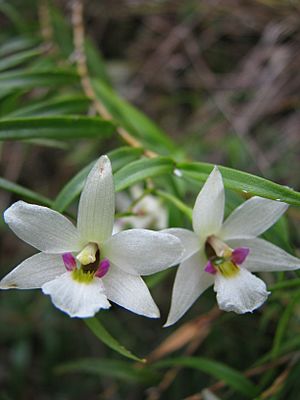Winika facts for kids
Quick facts for kids Winika |
|
|---|---|
 |
|
| Dendrobium cunninghamii in East Harbour Regional Park | |
| Scientific classification | |
| Synonyms | |
|
The Winika orchid, also known as the Christmas orchid or bamboo orchid, is a special plant found only in New Zealand. It is an epiphyte, which means it grows on other plants, like trees, but does not harm them. Sometimes, it can also grow on rocks.
You can find Winika in rainforests across New Zealand's North, South, Stewart, and Chatham Islands. This beautiful orchid usually blooms with flowers during the summer and early autumn months.
Contents
What Does the Winika Orchid Look Like?
The Winika orchid is a type of herbaceous plant that can grow quite large. It forms clumps up to 2 meters (about 6.5 feet) wide. Its stems are like thin wires or canes, growing up to 1 meter (about 3 feet) long and 7 millimeters (about 0.3 inches) thick.
The plant has many roots that grow from its underground stems, called rhizomes. Its leaves are long and narrow, about 30-50 millimeters (1.2-2 inches) long and 3 millimeters (0.1 inches) wide.
Winika Orchid Flowers
Winika orchids produce beautiful white flowers, usually 20-25 millimeters (0.8-1 inch) across. Up to eight flowers can grow on a short stem from the side of the plant.
While the main petals and sepals are white, parts of the flower's lip, called the labellum, have pretty rose pink, purplish, and green colors. The labellum has three parts. The two side parts are small and stand upright, often pink or purple. The middle part has four or five greenish or yellowish ridges along its center. Winika orchids typically flower from December to January.
Where Does the Winika Orchid Grow?
Winika orchids usually grow on forest trees, acting as epiphytes. They can also be found on fallen logs. Sometimes, they even grow on rocks, cliff faces, or even on brick or concrete walls!
This orchid is found on both the North and South Islands of New Zealand. It also grows on Stewart Island and the Chatham Islands.
The Story Behind the Winika Name
The scientific name for this orchid, Dendrobium cunninghamii, was first given in 1835 by a scientist named John Lindley. The second part of the name, cunninghamii, honors another botanist, Allan Cunningham.
Some scientists have suggested changing the name to Winika cunninghamii. This proposed name uses the old Māori language name for this orchid, Winika.
The name Te Winika was given to a very important war canoe of the Tainui people. This was because the orchid grew on the tōtara tree that was used to make the canoe's hull. The Māori Queen, Te Arikinui Dame Te Atairangikaahu, even gave her permission to use the name Winika because of its special meaning to her people.

